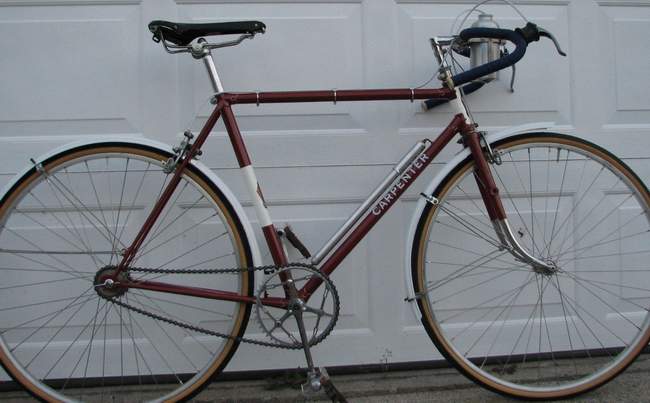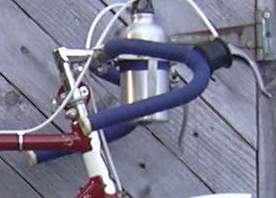Carpenter - 1948/9
Posted: Wednesday 12th August 2020
For those who have the patience, or interest, to read on further here is my account of both bike and its first ride ride:
At 5:45a.m. I rolled out of the driveway of my folks place (where we are on a mini-break) and out into the country around Kingston, Ontario. It was twilight – the moon was still out and almost full and there was a ground mist in places. As I rode eastwards, the sun rose like a huge orange ball in front of me – made even more spectacular by the mist which rolled in quite thickly at one point. It was a morning tailor-made for the Carpenter and she performed beautifully. I had been apprehensive before rolling out about whether everything would work, but most held up fine and I managed about 30km.
I ran a single-speed 18T Moyne fw with a Durax 47T chainring and 1/8 chain. It has been a long time since I have ridden a single-gear and I must admit it was a challenge, especially as the homeward ride was into the teeth of a very stiff westerly. I was glad to find out that I had got the cotter-pins set right and the cranks relatively parallel to each other. The chainset was fine – I decided not to have it replated yet as the budget had been long blown. It was fine although it does have a degree of wobble! I used Lyotard touring pedals (for my widish feet) with MKS clips (with leather toe covers). It has been many years since I rode clips and straps and it was interesting with my Sidi touring shoes without cleats – pulled out a couple of times.
I found the B-W 36H sf and Fiamme Yellow Label 26 X 1.25 clincher wheelset with Schwalbe tan-side walls performed well and ironed out the bumps etc. of a country road, but also had higher rolling resistance than I am used to on a regular basis. The front wheel was held on with GB alloy lever-style wingnuts, but I ended up having to use chromed steel wingnuts on the rear when one of the GBs stripped!! Expensive!
The Marsh style handlebars were a little awkward at first – I am not used to their narrowness. They were quite comfortable on the shallow drops though where the bars were wider. I am going to look for some other bars to try (I have a pair of Reynolds Maes bars already). The “honking rubbers” were remarkably comfortable places to rest my hands – but the levers were at an angle and I couldn’t depress them from the top of the levers as I usually do on other bikes. A major concern is that I have still not managed to get the stem clamp bolt tightened enough and the bars, rather disconsertingly, rotated on me when I tried to get out of the saddle and haul on the bars!!! I also found that the stem was too short – and I knew it might be – by about 2-3″ which left me a bit cramped. One brake lever was also fixed temporarily, which was not great, as the nut on the clamp had stripped and I could not get the clamp tightened – I ended up using some shims to secure it! I also need to redo the bar tape as it was done in a bit of a hurry in order to bring the bike down here with us.
| Frame | Carpenter - 1948/9; frame no. 4281; seat tube 21¼", top tube 22"', wheelbase 41", chainstays 17", bottom bracket 10½" with 26" wheels, 73/71 head/seat angles; fork rake 2¾" with 'D' blades; |
| Wheels | Fiamme Yellow Label 26" HP rims on Baylis Wiley small-flange double-fixed hubs - GB alloy wingnuts - see below |
| Chainset | Durax single 47T ring on Chater Lea BB |
| Pedals | Lyotard |
| Gears | Single-speed fixed/free |
| Brakes | GB Hiduminium |
| Stem/Bars | Marsh type bars on steel 'headclip' stem |
| Headset | Headclip |
| Saddle | Brooks Swallow with Reynolds seatpin |
| Extra details | Front and rear battery lamps; Bluemels Popular guards; Carradice Junior bag |
I finished the whole thing off with a chromed headlamp, a tail-light, a Carradice Junior bag with a bag-loop (thanks to Mark Ritz). The mudguards are Bluemel Populars, but a more modern set from Germany (thanks Doug). The bottle cage is period but the bottle was compromise as the budget couldn’t stretch to a Coloral. The blue handlebar tape (thanks John Wilson), with white Velox ends, picks up on the blue in the headbadge.
The headbadge is the original, but interestingly came from pre-War stock as the Penton St. shop had been bombed out during the War. The post-War badge with the newer address is on the seat-tube transfer. The paintwork was done by Mario Vaz and looks great although seems to be prone to chipping quite easily.
The bike is understated elegance – maroon with gold lug-lining and cream headtube and seat-tube panel. The frame is remarkably lightweight and has the most outrageous pencil stays. The chrome on the forks is original but the fork-crown chrome could not be saved. Likewise, the stay-ends were also chromed at one time but had been painted over and were not worth replating. All-in-all, what an amazing experience – a lovely responsive, true ride.
I am now in a sort of let-down phase and will have to find another project when the budget allows. I would like to thank everyone who helped me – with parts, advice, encouragement, etc. – it was at times a very steep learning curve. Above all else, my most sincere thanks go to Doug Smith who kept the frame for me for a couple of years before I could arrange to have it painted and shipped – Doug also supplied me with a number of parts.
Posted: Wednesday 12th August 2020
Upcoming Events
Whether you are looking for a gentle social meet up, or a 100-mile ride browse the community’s upcoming events and plan your next weekend outing.





